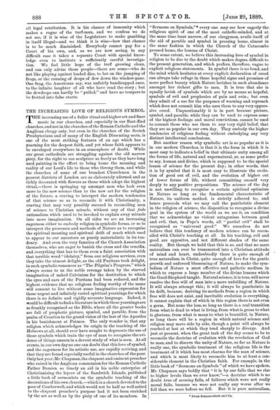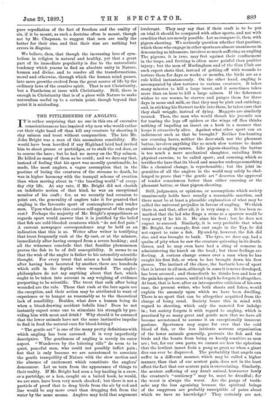THE INCREASING LOVE OF RELIGIOUS SYMBOL.
THE increasing use of a fuller ritual and higher art and finer music in our churches, and especially in our East-End churches, and not in the churches of the Roman Catholic and the Anglican clergy only, but even in the churches of the Scotch Presbyterians and of many of the English Dissenting sects, is one of the most striking features of an age which has a yearning for the deepest faith, and yet whose faith appears to be enveloped everywhere in an atmosphere of doubt. While our great cathedrals are struggling against the old narrow piety, for the right to use sculpture as freely as they have long used painting in the effort to bring home the meaning and reality of our Lord's life to those who throng them, and while the churches of some of our broadest Churchmen in the poorest districts of London are as elaborately adorned and as richly decorated with flowers as those which adopt the highest ritual,—there is springing up amongst men who look even more to the new science than to the new art for the religion of the future, a craving to interpret the modern tendencies of that science so as to reconcile it with Christianity, a craving that may very possibly succeed in reconciling men of science to Christian miracle, without any of that fade rationalism which used to be invoked to explain away miracle into mere imagination. On all sides we see an increasing eagerness either to embody religion in symbolic forms, or so to interpret the processes and methods of Nature as to recognise the spiritual meaning and spiritual drift of much which used to appear to our ancestors as purely materialistic in its ten- dency. And even the very fanatics of the Church Association themselves, who are eager to banish the cross and the crucifix, and everything that has to them even a faint association with that terrible word " idolatry," from our religious services, even they take the utmost delight, as the old Puritans took delight, in such symbolic romances as "The Pilgrim's Progress," which always seems to us the noble revenge taken by the starved imagination of naked Calvinism for the destitution to which the eyes and ears of the Puritans had been reduced, and the highest evidence that no religions feeling worthy of the name will consent to live without some imaginative expression for those urgent and infinitely varied spiritual yearnings for which there is no definite and rigidly accurate language. Indeed, it would be difficult to find a literature in which these yearnings are so frankly recognised as the Bible, where all the greater books are full of prophetic picture, symbol, and parable, from the psalm of Creation to the grand vision of the last of the Apostles in his banishment at Patmos. The only wonder is, that any religion which acknowledges its origin in the teaching of the Hebrews at all, should ever have sought to deprecate the use of those symbols which train the eye of man to recognise the evi- dence of things unseen in a devout study of what is seen. At all events, in our own dayno one can doubt that this love of symbol, and the eagerness for its artistic use, are rapidly reviving, and that they are found especially useful in the churches of the poor. Only last year, Mr. Chapman, the eloquent and eminent preacher who raised in the Anglican communion for the Roman Catholic Father Damien so timely an aid in his noble enterprise of Christianising the lepers of the Sandwich Islands, published a little book of sermonlets on the symbolic teaching of the decorations of his own church,—which is a church devoted to the poor of Camberwell, and which would not be half as well suited to the eloquent preacher's purpose had it not been enriched by the art as well as by the piety of one of its members. In
"Sermons on Symbols," every one may see how eagerly the religious spirit of one of the most catholic-minded, and at the same time least narrow, of our clergymen, avails itself of the aid of parable and symbol in pressing home, almost in the same fashion in which the Church of the Catacombs pressed home, the lessons of Christ.
To some extent, we believe this increasing love of symbol in religion to be due to the doubt which makes dogma difficult to the present generation, and which prefers, therefore, vague to explicit religious statements. In symbol there is no bond, and the mind which hesitates at every explicit declaration of creed can always take refuge in those hopeful signs and promises of more perfect beauty which Nature lavishes in such abundance amongst her richest gifts to men. It is true that she is equally lavish of symbols which are by no means so hopeful, symbols of evil and prophecies of pain and ruin ; but even they admit of a use for the purposes of warning and reproach which does not commit him who uses them to any very oppres- sive creed. Unquestionably it is in part because picture, symbol, and parable, while they can be used to express some of the highest feelings and moral convictions, cannot be used to commit those who use them to any very rigid belief, that they are so popular in our own day. They embody the higher tendencies of religious feeling without embodying any very distinct intellectual conclusions.
But another reason why symbolic art is so popular as it is in our modern Churches, is that it is the form in which it is most easy to indicate a belief in that ultimate unity among all the forms of life, natural and supernatural, or, as some prefer to say, human and divine, which is supposed to be the special lesson of science for the present day; in other words, that it is by symbol that it is most easy to illustrate the evolu- tion of good out of evil, and the evolution of higher out of lower forms of life, without committing oneself very deeply to any positive prepositions. The science of the day is not unwilling to recognise a certain spiritual optimism in Nature so long as the fundamental characteristic of Nature, its uniform method, is strictly adhered to; and hence proceeds what we may call the pantheistic element in the religion of science, the disposition to recognise a divine goal in the system of the world as we see it, on condition that we acknowledge no violent antagonism between good and evil, that, in Pope's words, all " partial evil" shall be recognised as "universal good." We ourselves do not believe that this tendency of modern science can be recon- ciled with Christ's teaching at all. In his teaching, evil and good are opposites, and not different shades of the same reality. But though we hold that this is so, and that no mere naturalism can ever be transmuted into a Christian attitude of mind and heart, undoubtedly there is quite enough of true naturalism in Christ, quite enough of love for the gentle growth and unforced blossoming of Nature, to make the sym- bolism of Nature a niost effective and pathetic medium in which to express a large number of the divine lessons which the Good Shepherd taught. Natural science, it is true, will never resolve the free will of man into a mere unfolding of Nature. It will always attempt this; it will always be pantheistic in its drift, because, deriving its methods from a region in which free will does not exist, and inevitable evolution is everything, it cannot explain that of which in this region there is not even a germ. But none the less, so long as there is a real transition from what is dead to what is living, from what is gross to what is glorious, from what is mean to what is beautiful, in Nature, so long there will be a region in which natural science and religion may move side by side, though a point will always be reached at last at which they tend sharply to diverge. And just at present, when the great task of the day seems to be to reconcile the doctrine of evolution with the revelation of God to man, and to discern the unity of Nature, so far as Nature is really one, the symbolic treatment of the religious life is the treatment of it which has most charms for the man of science, and which is most likely to reconcile him to at least a con- siderable element in the Christian faith. For example, in the little book of "Sermons on Symbols "of which we have spoken, Mr. Chapman says boldly that " it is by our falls that we rise to higher levels than we ever knew,"—a doctrine which is no doubt true of seeming falls, of failures which were not really moral falls, because we were not really any worse after we fell than we were before we fell. But' it is pure naturalism,
• Swan Sonnenschein ani Co.
pure repudiation of the fact of freedom and the reality of sin, if it be meant, as such a doctrine often is meant, though not by Mr. Chapman, to suggest that men are really the better for their sins, and that their sins are nothing but errors in disguise.
We believe, then, that though the increasing love of sym- bolism in religion is natural and healthy, yet that a great part of its immediate popularity is due to the naturalistic tendency which yearns to find an absolute unity in Nature, human and divine, and to resolve all the transformations, moral and otherwise, through which the human mind passes, into mere growths evolved from the great source of life by the ordinary laws of the creative spirit. That is not Christianity, but a Pantheism at issue with Christianity. Still, there is enough in Christianity that is of a piece with Nature to make naturalism useful up to a certain point, though beyond that point it is misleading.



































 Previous page
Previous page